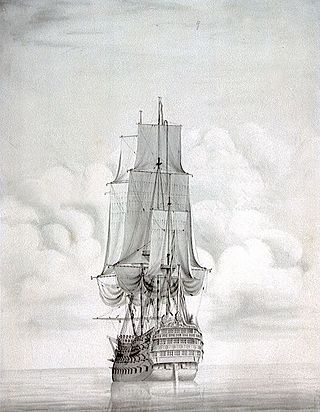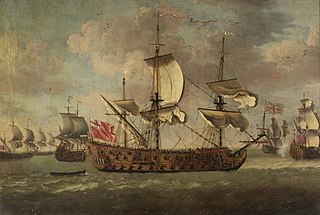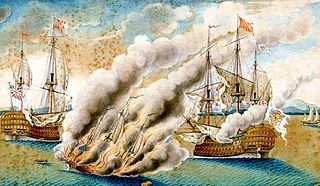
HMS Vanguard was a 90-gun second-rate ship of the line of the Royal Navy, built at Portsmouth Dockyard and launched in 1678.

HMS Hibernia was a 110-gun first-rate ship of the line of the Royal Navy. She was launched at Plymouth dockyard on 17 November 1804, and was the only ship built to her draught, designed by Sir John Henslow.

HMS Royal Oak was a 74-gun third-rate ship of the line of the Royal Navy, built by Jonas Shish at Deptford and launched in 1674. She was one of only three Royal Navy ships to be equipped with the Rupertinoe naval gun. Life aboard her when cruising in the Mediterranean Sea in 1679 is described in the diary of Henry Teonge.

HMS Northumberland was a 70-gun third-rate ship of the line of the Royal Navy, built at Deptford Dockyard and launched in 1705.

HMS Royal Sovereign was a 100-gun first rate ship of the line of the Royal Navy, built at Woolwich Dockyard and launched in July 1701. She had been built using some of the salvageable timbers from the previous Royal Sovereign, which had been destroyed by fire in 1697.
HMS Greenwich was a 54-gun fourth-rate ship of the line of the Royal Navy, built by Christopher Pett at Woolwich Dockyard and launched in 1666.

HMS Falkland was a 50-gun fourth-rate ship of the line of the Royal Navy, built by Holland of New Castle, New Hampshire, and purchased by the navy in 1696.

HMS Swiftsure was a 70-gun third-rate ship of the line of the Royal Navy, built by Sir Anthony Deane at Harwich, and launched in 1673. By 1685 she had been reduced to a 66-gun ship.

HMS Boyne was an 80-gun third-rate ship of the line of the Royal Navy, launched at Deptford Dockyard on 21 May 1692.

HMS Humber was an 80-gun third rate ship of the line of the Royal Navy, launched at Hull on 30 March 1693.

HMS Ipswich was a 70-gun third-rate ship of the line of the Royal Navy, launched at Harwich on 19 April 1694.

HMS Namur was a 90-gun second rate ship of the line of the Royal Navy, launched at Woolwich Dockyard in 1697.

HMS Guernsey was a 50-gun fourth rate ship of the line of the Royal Navy, one of four ordered in September 1694 to be built by commercial contracts; eight further ships of this type were ordered on 24 December. The Guernsey was built by Sir Henry Johnson's Blackwall Yard and launched on 6 July 1696.

HMS Mary was a 60-gun fourth rate ship of the line of the Royal Navy, built at Chatham Dockyard and launched on 12 May 1704.

HMS Grafton was a 70-gun third rate ship of the line of the Royal Navy. She was built by Swallow and Fowler, of Limehouse, London, to the dimensions of the 1706 Establishment, and was launched on 9 August 1709.

HMS Hampton Court was a 70-gun third-rate ship of the line of the Royal Navy, built at Rotherhithe according to the 1706 Establishment and launched on 19 August 1709.
HMS Romney was a 50-gun fourth rate ship of the line of the Royal Navy, built by Sir Joseph Allin to the 1706 Establishment at Deptford Dockyard, and launched on 2 December 1708.

HMS Hampshire was a 50-gun fourth rate ship of the line of the Royal Navy, built at Ipswich by John Barnard to the 1733 proposals of the 1719 Establishment dimensions at Ipswich, and launched on 13 November 1741.

HMS Defiance was a 58-gun fourth rate ship of the line of the Royal Navy, built to the dimensions laid out in the 1741 proposals of the 1719 Establishment at Deptford, and launched on 12 October 1744.

Henry Adams (1713–1805) was a British Master Shipbuilder. He lived and worked at Bucklers Hard in Hampshire between 1744 and 1805.
















